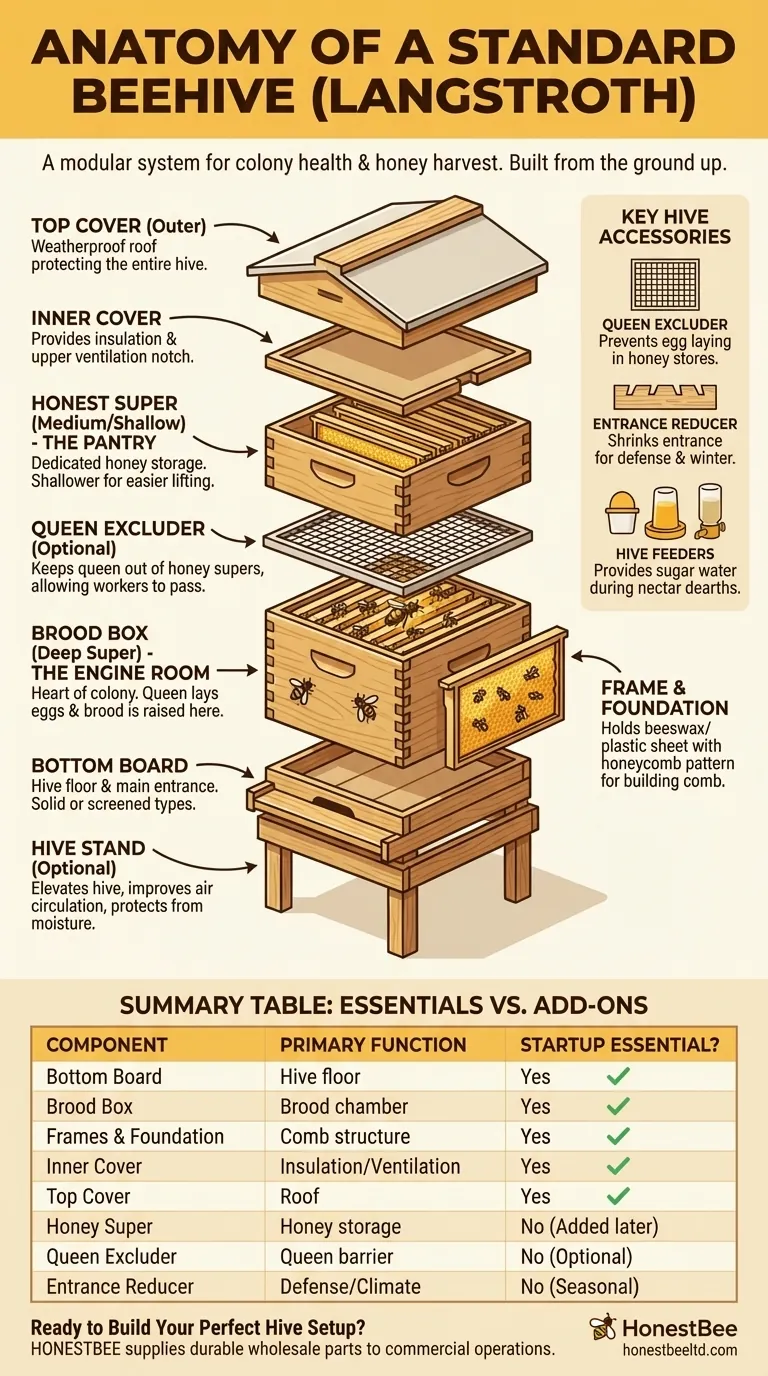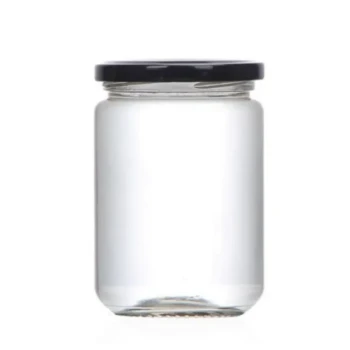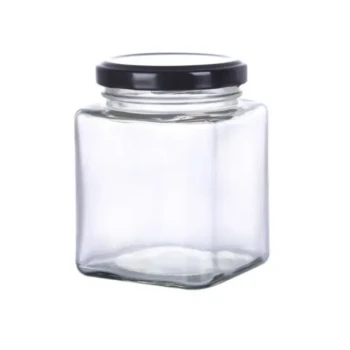At its core, a standard beehive is a modular system of boxes. The most basic setup consists of a bottom board, one or more boxes called "supers" filled with frames, an inner cover for ventilation, and a protective outer top cover. These components stack vertically to create a functional, expandable home for a honey bee colony.
A beehive is not just a container; it's a carefully designed structure that mimics a tree cavity. Each part serves a specific function, allowing beekeepers to manage the colony's health, support its growth, and harvest surplus honey with minimal disruption to the bees.

Anatomy of a Langstroth Hive: From the Ground Up
The most common type of hive used in modern beekeeping is the Langstroth hive. Its design is based on the principle of "bee space," allowing components to be removed and inspected. We can understand its structure by building it from the bottom up.
The Foundation: Hive Stand and Bottom Board
A hive stand is an optional but highly recommended base that elevates the hive off the ground. This improves air circulation, protects the wood from moisture, and makes it harder for pests to enter.
The bottom board serves as the floor of the hive. It has raised sides that create the hive's main entrance for the bees. Bottom boards come in two main types: solid or screened, with screened bottoms offering better ventilation and mite control.
The Engine Room: Brood Box and Frames
The brood box (also called a deep super or hive body) is the first and largest box in the stack. This is the heart of the colony, where the queen lays her eggs and the bees raise the next generation of "brood."
Inside the brood box hang a series of frames. Each frame holds a sheet of foundation—typically made of beeswax or plastic—imprinted with a honeycomb pattern. This foundation provides a guide for the bees to build out their wax comb for raising brood and storing food.
The Pantry: Honey Supers
As the colony grows and fills the brood box, the beekeeper adds honey supers on top. These are the boxes dedicated to honey storage.
Honey supers are often shallower than the brood box ("mediums" or "shallows"), making them lighter and easier to lift when full of heavy honey.
The Lid: Inner and Top Covers
The inner cover is a flat board placed on top of the uppermost super. It provides an insulating layer of dead air and often has a small notch to create an upper entrance or ventilation point.
Finally, the top cover (or outer cover) acts as the roof of the beehive. It is typically a telescoping cover that fits over the top of the hive, protecting the entire structure from rain, sun, and other weather elements.
Understanding Key Hive Accessories
Beyond the core components, several accessories are used to manage the hive at different stages. These are not always essential for day one, but they are critical tools for effective beekeeping.
The Queen Excluder
A queen excluder is a flat grid of wire or plastic placed between the brood box and the honey supers. The slots are large enough for worker bees to pass through but too small for the larger queen.
The purpose is to keep the queen from laying eggs in the honey supers, ensuring they contain only pure honey. However, some beekeepers avoid them, believing they can slow down worker bee traffic and reduce honey production.
The Entrance Reducer
An entrance reducer is a small piece of wood with different-sized notches cut into it. It fits into the main entrance on the bottom board to shrink the size of the opening.
This is critical for new or weak colonies, as it helps them defend their home from robber bees or wasps. It is also commonly used in winter to help the bees retain heat.
Hive Feeders
Feeders are used to provide sugar water to a colony when natural nectar sources are scarce, such as during early spring or a summer dearth. They come in various styles, including entrance feeders, top feeders, and frame feeders.
Assembling Your First Hive
Your initial hive configuration depends directly on your immediate goal. Not all parts are needed at once, and the hive will grow with your colony.
- If your primary focus is starting a new colony: You need the essentials: a bottom board, one deep brood box with frames and foundation, an inner cover, and a top cover.
- If your primary focus is preparing for honey collection: You will add one or more honey supers and potentially a queen excluder on top of your established brood box as the nectar flow begins.
- If your primary focus is managing the hive through the seasons: You will use accessories like entrance reducers for winter and feeders during nectar shortages to ensure the colony's long-term health.
Understanding these components transforms a simple set of boxes into a dynamic, manageable ecosystem for your bees.
Summary Table:
| Hive Component | Primary Function | Essential for Startup? |
|---|---|---|
| Bottom Board | Hive floor and main entrance | Yes |
| Brood Box (Deep Super) | Chamber for queen to lay eggs and raise brood | Yes |
| Frames & Foundation | Structure for bees to build honeycomb | Yes |
| Inner Cover | Insulation and upper ventilation | Yes |
| Top Cover | Weatherproof roof for the hive | Yes |
| Honey Super | Box dedicated to honey storage | No (Added later) |
| Queen Excluder | Keeps queen out of honey supers | No (Optional) |
| Entrance Reducer | Helps small colonies defend the hive | No (Seasonal) |
Ready to Build Your Perfect Hive Setup?
Understanding the components is the first step. HONESTBEE supplies high-quality beekeeping supplies and equipment to commercial apiaries and beekeeping equipment distributors through wholesale-focused operations. We provide the durable, reliable parts you need—from bottom boards to honey supers—to build a thriving, productive operation.
Let us help you succeed. Contact our team today to discuss your specific needs and get a quote on wholesale supplies.
Visual Guide

Related Products
- Professional Insulated Winter Hive Wrap for Beekeeping
- Versatile Ratchet Hive Strap with S-Hooks for Secure Fastening
- Professional Durable Two-Piece Plastic Bee Escape
- Multi-Functional Rotary Hive Entrance Disc for Beekeeping
- Multi-Functional Sliding Hive Entrance for Beekeeping
People Also Ask
- What are the steps to properly wrap a beehive for winter? Ensure Your Colony Survives the Cold
- Why is insulation important for hives during winter? Ensure Your Bees Survive and Thrive
- Should bee hives be insulated? Protect Your Colony from Moisture, Not Just Cold
- How does insulation help bee hives in severely cold weather? Conserve Energy & Ensure Colony Survival
- What are the benefits of insulated beehives in cold weather? Boost Winter Survival & Spring Productivity



















